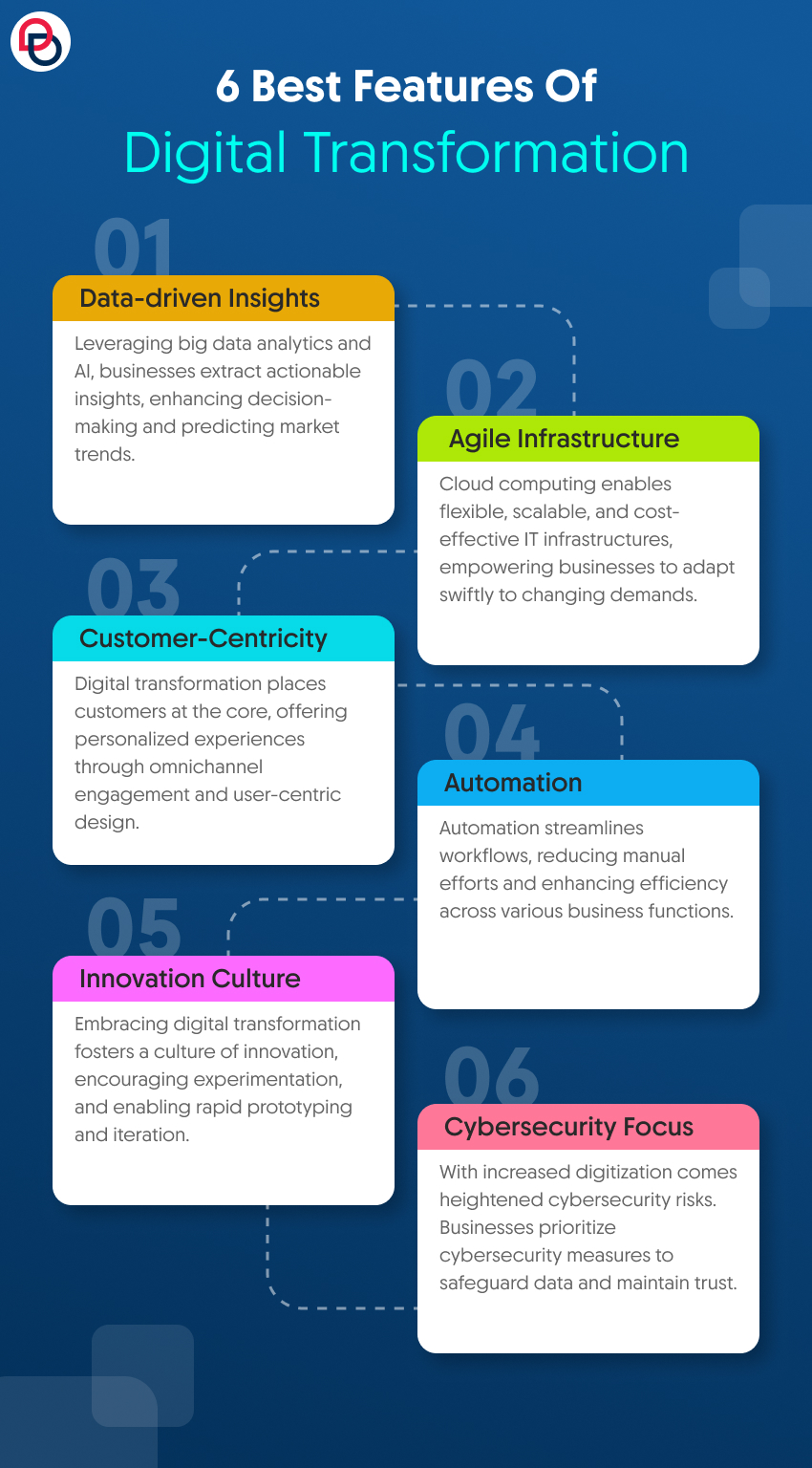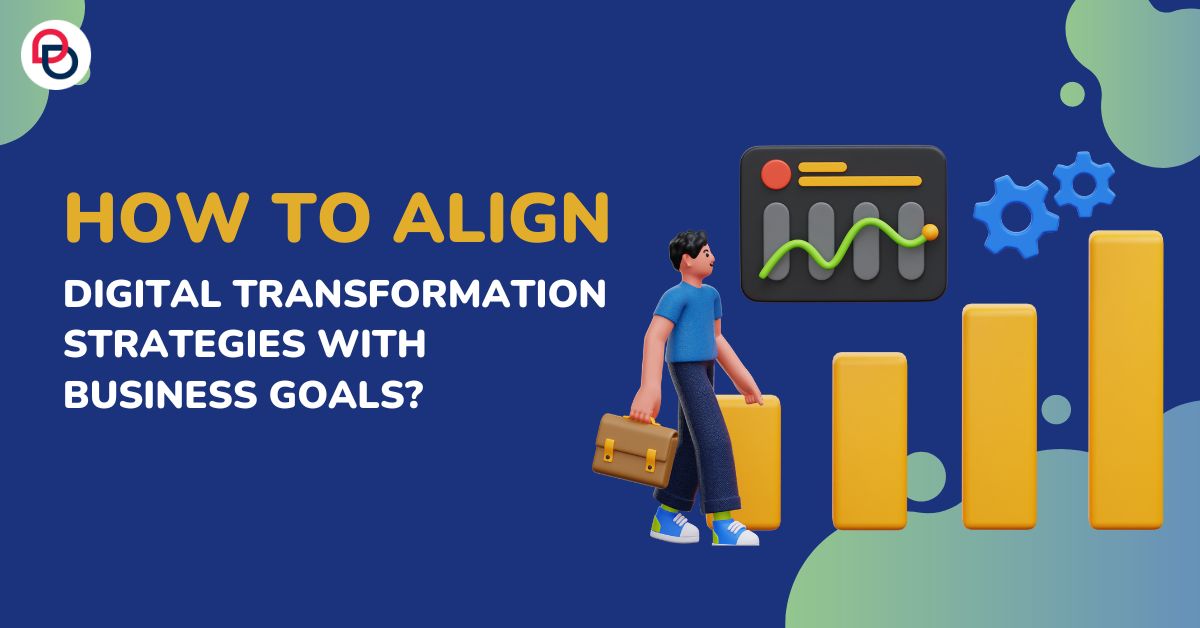How to Align Digital Transformation Strategies with Business Goals?
Summary: Digital transformation strategies are a strategic roadmap for implementing digital technology to assist your firm achieve its higher-level goals.
Many organizations, particularly major enterprises, have already begun their digital transformation path. There is no doubt that big data analytics and other data-driven technologies hold immense promise for improving processes, goods, and services. To fully realize the potential of digital transformation projects, they must be connected with business goals.
Globally, the digital transformation market was valued at USD 879.18 billion in 2023 and is expected to increase at a CAGR of 28.1% between 2024 – 2030. The market has grown due to the increased adoption of cutting-edge technologies like cyber security, AI, big data analytics, and cloud. These technologies have led to business transformation and innovation, resulting in increased revenue.
What is Digital Transformation?
Digital transformation is a substantial business change that has a significant impact on the opportunities offered by digital technologies. It has an impact on company activities, processes, competencies, and models used to create value for customers, acquire new capabilities in response to fast-changing market requirements, manage risk, and increase efficiency.
IT digital transformation is more than just using new technologies. It affects the entire organization, not just the toolset, but also workflows, structure, customer service, style of thinking, management, and other facets of a business operation. Well-thought-out digital transformation strategies and cross-functional collaboration are the two keys to success in this process.
IT digital transformation has numerous benefits for business operations and client interactions:
- Improved efficiency: Automation and digital technologies expedite operations, decreasing manual labor and operational expenses while increasing efficiency.
- Improved customer experience: IT digital transformation provides individualized interactions, faster responses, and seamless transactions leading to higher customer satisfaction.
- Increased agility: Digital technology allows for speedier adaptation to market changes, helping organizations stay adaptable and competitive in changing landscapes.
- Data-driven decision-making: Comprehensive data and analytics enable educated decision-making, resulting in strategic and effective business choices.
- Innovation opportunities: Embracing digital transformation creates an atmosphere for innovation, leading to the development of new goods, services, and market offerings.
- Scalability and growth: Digital technologies enable firms to expand and reach new customers more efficiently.
- Improved cooperation: Digital tools enable seamless cooperation among teams and stakeholders, regardless of geographical obstacles, leading to increased teamwork and production.
- Improved security: Modern IT digital transformation uses strong security standards to safeguard data and prevent cyber threats and breaches.
Examples of digital transformation include transitioning to a cloud environment, becoming remote-ready, reskilling personnel, introducing automation to speed up customer support and service, and leveraging AI-driven insights to improve sales efficiency.
There are several real-life instances of firms undergoing digital transformation in areas such as banking, healthcare, communications, manufacturing, construction, logistics, and others to reinvent individual business cases or their entire company.
So, let’s explore the top features of digital transformation that make it suitable for every business around the world.
Top 6 Best Features Of Digital Transformation

In the age of rapid technological advancements, IT digital transformation has emerged as a pivotal strategy for organizations aiming to thrive in the digital landscape. This transformation encompasses a variety of features that enable businesses to adapt, evolve, and stay competitive in the ever-changing market dynamics.
Here are six of the most crucial features that contribute to the success of digital transformation:
- Data-driven insights
Data-driven insights form the backbone of digital transformation strategies and initiatives. By leveraging big data analytics and advanced machine learning algorithms, organizations can extract valuable insights from vast amounts of structured and unstructured data. These insights help in understanding market trends, customer behavior, and operational inefficiencies. With a data-driven approach, businesses can make informed decisions, optimize processes, and identify new growth opportunities.
- Agile infrastructure
Digital transformation strategies emphasize the adoption of agile infrastructure solutions, such as cloud computing and containerization, to enhance scalability, flexibility, and responsiveness. Agile infrastructure enables organizations to rapidly deploy and scale applications, streamline development workflows, and efficiently manage resources.
- Customer-centricity
In the digital era, there is a significant increase in customer expectations. IT digital transformation encourages a customer-centric approach, focusing on delivering personalized experiences across all touchpoints. By utilizing customer data, companies can gain adequate insights into customer behaviors, preferences, and pain points. This enables them to tailor products, services, and marketing strategies to meet the evolving needs of their target audience, thereby enhancing customer satisfaction and loyalty.
- Automation
Automation lies at the heart of IT digital transformation, empowering organizations to automate repetitive tasks, streamline workflows, and drive operational efficiency. Through the use of robotic process automation (RPA), artificial intelligence (AI), and machine learning (ML), businesses can automate manual processes across various functions, including finance, HR, marketing, and customer service. Automation not only reduces human errors and operational costs but also frees up employees to focus on more strategic and value-added activities.
- Innovation culture
IT digital transformation fosters a culture of innovation within organizations, encouraging employees to think creatively, experiment with new ideas, and embrace change. By promoting a culture of continuous learning and improvement, businesses can drive innovation at every level, from product development to customer service. This requires leadership support, cross-functional collaboration, and a willingness to take calculated risks. Cultivating an innovation culture enables organizations to stay ahead of the curve and drive sustainable growth in the digital age.
- Cybersecurity focus
As digital ecosystems become increasingly interconnected, cybersecurity has become a top priority for organizations undergoing digital transformation. With the rise of cyber threats such as data breaches, ransomware attacks, and phishing scams, protecting sensitive information and ensuring data privacy has never been more critical. Digital transformation strategies must incorporate robust cybersecurity measures, including encryption, multi-factor authentication, intrusion detection systems, and regular security audits. Businesses can protect their assets by prioritizing cybersecurity. This helps them to build trust with customers, and eliminate the risks associated with digital operations.
What are the 7 Key Steps of Digital Transformation Strategies?
Digital transformation strategies outline how a business will use digital technology to continuously produce new goods, services, processes, and engagement channels, as well as reformulate current ones, to satisfy changing consumer wants and market conditions.
Ideally, a digital transformation plan articulates the organization’s goals and gives high-level guidance on how digital technologies will be employed to achieve them.
Here are 7 crucial steps to developing an effective digital transformation strategy:
- Define clear objectives and goals
The first step in any IT digital transformation journey is to define clear objectives and goals. Whether it’s improving operational efficiency, enhancing customer experience, or entering new markets, defining specific, measurable, achievable, relevant, and time-bound (SMART) goals is crucial. Understanding what success looks like will guide decision-making throughout the transformation process.
- Assess the current state and identify gaps
Before implementing any digital initiatives, it’s essential to conduct a thorough assessment of the organization’s current state. This involves evaluating existing processes, technologies, and capabilities to identify strengths, weaknesses, opportunities, and threats (SWOT analysis). By understanding current gaps and pain points, organizations can prioritize areas for improvement and allocate resources effectively.
- Embrace a customer-centric approach
Successful digital transformation strategies revolve around meeting the evolving needs and expectations of customers. Organizations must adopt a customer-centric approach by gaining deep insights into customer behaviors, preferences, and pain points. Leveraging data analytics, market research, and customer feedback enables organizations to personalize experiences, anticipate needs, and deliver value at every touchpoint.
- Cultivate a culture of innovation and agility
IT digital transformation requires a cultural shift within the organization. Leaders must foster a culture of innovation, collaboration, and agility to drive continuous improvement and adaptation. Empowering employees to challenge the status quo, encouraging experimentation, and embracing failure as a learning opportunity are essential aspects of fostering an innovative culture. Additionally, adopting agile methodologies allows organizations to respond swiftly to market changes and customer feedback.
- Invest in talent and skills development
People are at the heart of digital transformation. Investing in talent acquisition and skills development is critical to building a workforce capable of driving change and innovation. Organizations should provide training programs, workshops, and upskilling opportunities to equip employees with the necessary digital competencies. Furthermore, fostering a learning mindset encourages employees to stay abreast of emerging technologies and industry trends.
- Implement robust technology infrastructure
Technology serves as the backbone of IT digital transformation. Organizations must invest in building a robust technology infrastructure that supports scalability, security, and interoperability. This may involve adopting cloud computing, leveraging data analytics tools, implementing cybersecurity measures, and integrating disparate systems for seamless data flow. Choosing the right technology partners and solutions that align with business objectives is paramount.
- Monitor progress and iterate continuously
IT digital transformation is an ongoing journey rather than a one-time initiative. It’s essential to establish key performance indicators (KPIs) and metrics to monitor progress and measure the impact of digital initiatives. Regularly reviewing performance data and soliciting feedback from stakeholders enables organizations to identify areas for improvement and make course corrections as needed. Embracing a mindset of continuous iteration and adaptation is crucial for staying ahead in today’s dynamic business environment.
When you should hire digital transformation services companies?
Hiring digital transformation consultants offers numerous advantages. For instance, they have specific expertise and abilities that would be difficult or costly to acquire internally. Furthermore, an experienced agency may provide objective insights into your current operations, which can help you find areas for improvement or places where existing techniques are effective. Finally, their knowledge enables them to quickly deploy new ideas, so you may see benefits sooner rather than later.
So, when you should hire one? Let’s find out.
- Increased efficiency
Businesses can benefit from the digital transformation services companies to boost operational efficiency. They use cutting-edge technology and expertise to simplify procedures and develop novel approaches to automate time-consuming chores. This can lead to increased productivity, reduced expenses, and lower operational hazards. Companies that work with a digital transformation expert can acquire a competitive advantage in the market.
- Better customer experience
Digital transformation consultants offer the tools essential to enhance client experiences, improving client retention rate. They understand how customers engage with online services, allowing them to create improved user interfaces that make it easier for them to do business with you. Investing in such knowledge ensures that your customer experience is exceptional and that customers return time and again.
- Innovation
Digital transformation organizations also offer new solutions to assist businesses stay ahead of competitors. These solutions frequently make use of developing technology such as artificial intelligence (AI) and machine learning (ML). Businesses can use these technologies to create products and services that are more appealing to customers than competitors’ offerings. Furthermore, these solutions may enable firms to discover new opportunities in their field or enter markets that they would not have been able to reach previously.
- Data analysis and insights
Digital transformation strategists provide vital insights into customer behavior patterns via analytics and data collection approaches such as A/B testing or cohort analysis. This data enables businesses to obtain vital insights into how their clients interact with their website or product offers, allowing them to modify accordingly or focus on specific areas that require improvement. This data enables businesses to make informed decisions about product development or marketing initiatives, allowing them to spend resources effectively while maximizing the return on their investment.
Wrapping Up
Digital transformation strategies are an approach for reshaping existing business models and changing organizational culture while implementing digital innovations. An effective digital transformation strategy is aligned with corporate objectives and pursues specific outcomes such as enhancing work process efficiency, expanding growth, or cutting operational expenses.




